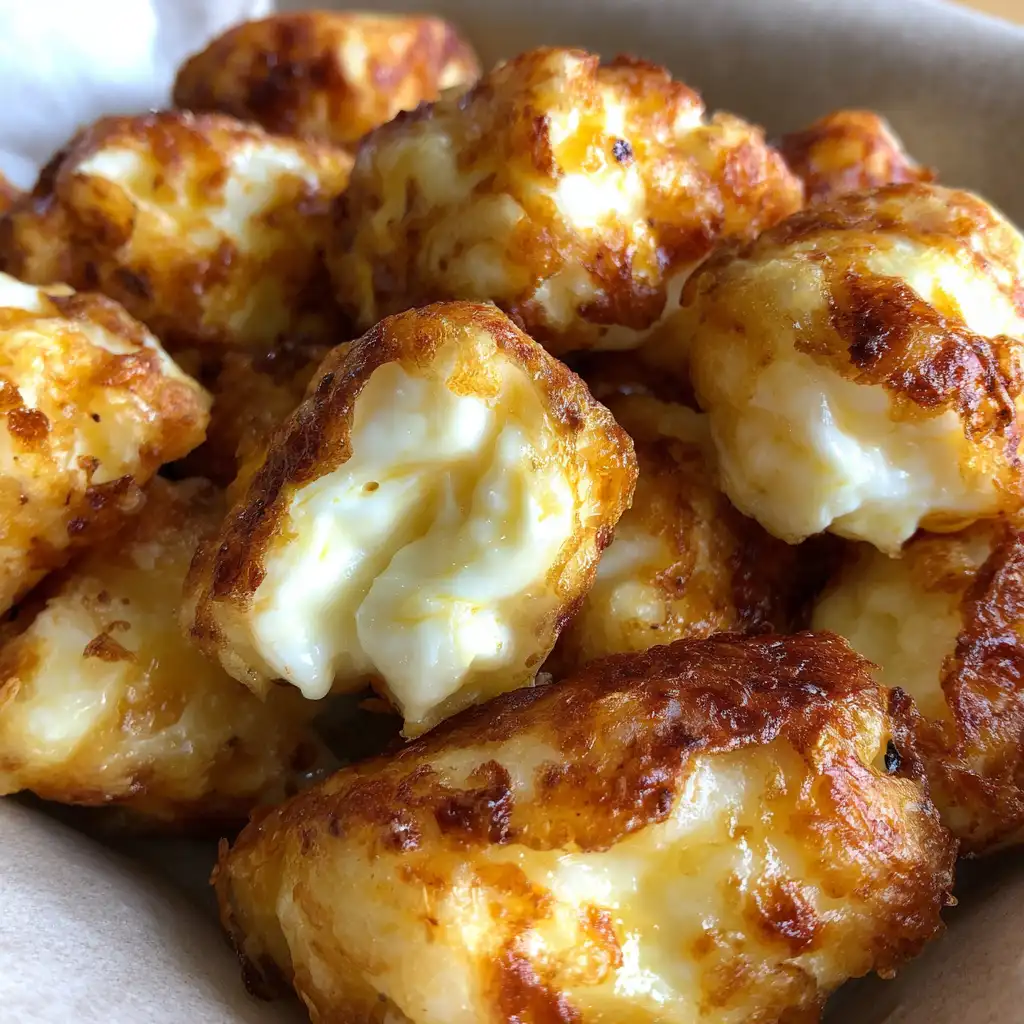Cheese curds are small, soft lumps of curdled milk. They are a delightful byproduct of the cheese-making process. When milk is heated and combined with rennet, it separates into curds and whey. The curds are the solid part, while the whey is the liquid. Cheese curds have a mild flavor and a unique, squeaky texture that many people love. They can be enjoyed fresh or cooked, making them a versatile ingredient in various dishes.
The History of Cheese Curds
The history of cheese curds dates back centuries. They originated in Europe, where cheese-making was a common practice. In fact, cheese curds are especially popular in regions like Wisconsin, USA, and Quebec, Canada. These areas have a rich dairy farming tradition, which has led to the creation of many delicious cheese varieties. Over time, cheese curds became a beloved snack and ingredient in many recipes. Today, they are enjoyed by people all over the world, often served as a tasty treat or appetizer.
Ingredients for Making Cheese Curds
To create delicious cheese curds, you need a few simple ingredients. Each component plays a vital role in the cheese-making process. Here’s what you’ll need:
- Fresh cheese curds: 500 grams. These are the star of the show! Look for curds that are soft and squeaky for the best results.
- Whole milk: 1 cup. Whole milk provides the richness needed for creamy curds. You can also use raw milk for a more authentic flavor.
- Salt: 1 teaspoon. Salt enhances the flavor of the curds and helps preserve them.
- Olive oil or butter: About 2 tablespoons for frying. This adds a crispy texture and delicious taste to the curds.
- Optional herbs or spices: To taste. Consider adding garlic powder, paprika, or dried herbs for extra flavor.
Gathering these ingredients is the first step toward making your own cheese curds. Each item contributes to the overall taste and texture, ensuring a delightful snack or appetizer. Now that you have everything ready, you can move on to the preparation process!
Preparation of Cheese Curds

Step 1: Gather Your Ingredients
Before you start making cheese curds, it’s essential to gather all your ingredients. This includes fresh cheese curds, whole milk, salt, and any optional herbs or spices you want to use. Having everything ready will make the process smoother and more enjoyable. Make sure your cheese curds are fresh for the best flavor and texture.
Step 2: Heat the Milk
Next, pour the whole milk into a large pot. Heat the milk over medium heat until it reaches about 85°F (29°C). Stir gently to prevent the milk from scorching. This step is crucial as it prepares the milk for the next stage of curd formation. Once the milk is warm, you’re ready to move on!
Step 3: Add Rennet and Culture
Now, it’s time to add the rennet and culture to the warm milk. Rennet is an enzyme that helps the milk coagulate, while the culture adds flavor. Follow the instructions on your rennet package for the correct amount. Stir gently for about 30 seconds, then let the mixture sit undisturbed for about 5-10 minutes. You should see the milk begin to thicken and form curds.
Step 4: Cut the Curd
Once the curds have formed, it’s time to cut them. Use a long knife to cut the curds into small cubes, about 1-inch in size. This helps release the whey and allows the curds to cook evenly. Be gentle during this process to avoid breaking the curds too much. After cutting, let the curds rest for another 5 minutes.
Step 5: Cook the Curd
Now, you’ll need to cook the curds. Gradually heat the curds to about 105°F (40°C) while gently stirring. This step helps firm up the curds and enhances their texture. Keep stirring for about 30 minutes, ensuring the curds don’t stick together. Once they reach the desired temperature, remove them from the heat.
Step 6: Drain the Whey
After cooking, it’s time to drain the whey. Place a colander over a large bowl and pour the curds into it. Allow the whey to drain for about 5-10 minutes. You can save the whey for other recipes, like smoothies or baking. This step is essential for achieving the right consistency in your cheese curds.
Step 7: Rinse and Salt the Curds
Once drained, rinse the curds under cold water. This helps cool them down and removes any residual whey. After rinsing, sprinkle the salt over the curds and mix gently. The salt not only adds flavor but also helps preserve the curds. Taste a curd to see if it needs more salt.
Step 8: Shape and Store the Cheese Curds
Finally, it’s time to shape and store your cheese curds. You can either leave them as is or press them into molds for a more uniform shape. Place the curds in an airtight container and store them in the refrigerator. They are best enjoyed fresh but can last for a few days. Now, you’re ready to enjoy your homemade cheese curds!
Tips for Perfect Cheese Curds
Choosing the Right Milk
When making cheese curds, the type of milk you use is crucial. Fresh, high-quality milk will yield the best results. Whole milk is ideal because it has a rich fat content that contributes to creamy curds. If possible, opt for raw milk from a local dairy. This type of milk often has a fresher taste and can enhance the flavor of your cheese curds. Remember, the fresher the milk, the better your curds will be!
Temperature Control
Temperature plays a significant role in cheese-making. Keeping the milk at the right temperature is essential for curd formation. When heating the milk, use a thermometer to ensure accuracy. If the milk gets too hot, it can scorch, ruining the flavor. Likewise, when cooking the curds, maintain a steady temperature. Too much heat can make the curds tough. Aim for gradual heating to achieve that perfect, soft texture.
Timing is Key
Timing is another important factor in making cheese curds. Each step in the process has a specific duration that should be followed closely. For instance, letting the curds rest after cutting is vital for proper whey drainage. If you rush this step, your curds may not develop the right texture. Similarly, when cooking the curds, be patient. Stirring for the recommended time ensures they firm up nicely. Remember, good things take time, and cheese curds are no exception!
Variation of Cheese Curds
Flavored Cheese Curds
Flavored cheese curds are a fun twist on the classic recipe. You can easily customize your cheese curds by adding different herbs and spices. For example, try mixing in garlic powder for a savory kick or paprika for a hint of smokiness. You can also experiment with fresh herbs like basil or dill for a refreshing taste. The possibilities are endless! Just remember to add these flavors during the seasoning step to ensure they blend well with the curds. Flavored cheese curds make a delightful snack or appetizer that will impress your guests.
Different Curd Sizes
Another variation to consider is the size of your cheese curds. You can make small, bite-sized curds or larger pieces, depending on your preference. Smaller curds are perfect for snacking, while larger ones can be used in salads or as a topping for dishes. When cutting the curds, simply adjust the size to suit your needs. Keep in mind that smaller curds may cook faster, so watch them closely while frying. No matter the size, cheese curds are sure to be a hit!
FAQs About Cheese Curds
What is the difference between cheese curds and regular cheese?
Cheese curds and regular cheese are closely related but differ in texture and taste. Cheese curds are the fresh, unaged version of cheese. They are soft, moist, and have a squeaky texture when bitten into. Regular cheese, on the other hand, is aged and has a firmer texture. The aging process allows flavors to develop, making it richer and more complex. In short, cheese curds are the building blocks of cheese, enjoyed fresh, while regular cheese is the final product that has matured over time.
How long do cheese curds last?
Fresh cheese curds are best enjoyed within a few days of making them. When stored properly in an airtight container in the refrigerator, they can last about 5 to 7 days. However, for the best flavor and texture, try to consume them as soon as possible. If you notice any off smells or changes in texture, it’s best to discard them. Remember, fresh is always best when it comes to cheese curds!
Can you freeze cheese curds?
Yes, you can freeze cheese curds! Freezing can help extend their shelf life. To freeze cheese curds, place them in an airtight container or freezer bag. Make sure to remove as much air as possible to prevent freezer burn. They can last up to 6 months in the freezer. However, keep in mind that freezing may change their texture slightly, making them less squeaky. When you’re ready to use them, thaw the curds in the refrigerator before enjoying them in your favorite dishes.
How do you eat cheese curds?
Cheese curds can be enjoyed in many ways! They are delicious on their own as a snack, especially when fresh. You can also fry them for a crispy treat, as mentioned in the recipe above. Cheese curds are often used in poutine, a popular Canadian dish, where they are topped with gravy and fries. Additionally, they can be added to salads, sandwiches, or even melted on pizzas. The versatility of cheese curds makes them a delightful addition to any meal!
Print
Cheese curds
- Total Time: 1 hour 30 minutes
- Yield: Approximately 500 grams of cheese curds
- Diet: Vegetarian
Description
Cheese curds are small, soft lumps of curdled milk that are a delightful byproduct of the cheese-making process. They have a mild flavor and a unique, squeaky texture, making them a versatile ingredient in various dishes.
Ingredients
- Fresh cheese curds: 500 grams
- Whole milk: 1 cup
- Salt: 1 teaspoon
- Olive oil or butter: About 2 tablespoons for frying
- Optional herbs or spices: To taste
Instructions
- Gather your ingredients.
- Heat the milk over medium heat until it reaches about 85°F (29°C).
- Add rennet and culture to the warm milk and stir gently.
- Cut the curds into small cubes, about 1-inch in size.
- Cook the curds gradually to about 105°F (40°C) while gently stirring.
- Drain the whey using a colander.
- Rinse the curds under cold water and sprinkle with salt.
- Shape and store the cheese curds in an airtight container in the refrigerator.
Latest Amazon Finds
Notes
- Use fresh, high-quality milk for the best results.
- Maintain proper temperature control during the cheese-making process.
- Timing is crucial for each step to achieve the right texture.
- Prep Time: 30 minutes
- Cook Time: 1 hour
- Category: Snack/Appetizer
- Method: Frying/Boiling
- Cuisine: American/Canadian
Nutrition
- Serving Size: 100 grams
- Calories: 300
- Sugar: 1 g
- Sodium: 400 mg
- Fat: 24 g
- Saturated Fat: 15 g
- Unsaturated Fat: 8 g
- Trans Fat: 0 g
- Carbohydrates: 2 g
- Fiber: 0 g
- Protein: 20 g
- Cholesterol: 70 mg
Keywords: cheese curds, snack, appetizer, cheese-making, dairy








